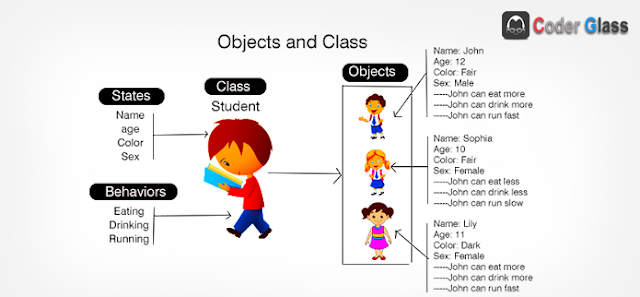Class and Inheritance
Class
A class is an abstract concept that describes what the object will contain and how an object will behave. In other words, it is a blueprint or prototype that defines the states (properties) and the behaviors (methods) common to all objects of a certain kind. As shown in the following image, the Student class describes some states and behaviors that all students share. Objects are often used to model real-world objects you find in everyday life. An object is a specimen of a class. They all have their own specific states and behaviors.

In Typescript, a class can include the following:
- Constructor
- Properties
- Methods
class Employee {
empCode: number;
empName: string;
constructor(code: number, name: string) {
this.empName = name;
this.empCode = code;
}
getSalary(): number {
return 10000;
}
}
The TypeScript compiler will convert the above class to the following JavaScript code using IIFE:
var Employee = /** @class */ (function () {
function Employee(name, code) {
this.empName = name;
this.empCode = code;
}
Employee.prototype.getSalary = function () {
return 10000;
};
return Employee;
})();
Constructor
The constructor is a special type of method which is called when creating an object. In TypeScript, the constructor method is always defined with the name "constructor".
class Employee {
empCode: number;
empName: string;
constructor(empcode: number, name: string) {
this.empCode = empcode;
this.name = name;
}
}
In the above example, the Employee class includes a constructor with the parameters empcode and name. In the constructor, members of the class can be accessed using this keyword e.g. this.empCode or this.name.
Constructor is optional
It is not necessary for a class to have a constructor.
class Employee {
empCode: number;
empName: string;
}
Property initializer
This is a nifty feature supported by TypeScript (from ES7 actually). You can initialize any member of the class outside the class constructor, useful to provide default (notice members = [])
class Foo {
members = []; // Initialize directly
add(x) {
this.members.push(x);
}
}
The previous example is equivalent to a similar assignment within a constructor body.
class Foo {
constructor() {
this.members = [];
}
add(x) {
this.members.push(x);
}
}
Creating an Object of Class
An object of the class can be created using the new keyword.
class Employee {
empCode: number;
empName: string;
constructor(empcode: number, name: string) {
this.empCode = empcode;
this.name = name;
}
}
let emp = new Employee(100, 'Steve');
Here, we create an object called emp of type Employee using let emp = new Employee(100,"Steve");. The above class include a parameterized constructor so we pass values while creating an object. When we instantiate a new object, the class constructor is called with the values passed and the member variables empCode and empName are initialized with these values. If the class does not include any parameterized constructor, then we cannot pass values while creating an object. Otherwise the compiler will show an error.
Inheritance
Just like object-oriented languages such as Java and C#, TypeScript classes can be extended to create new classes with inheritance, using the keyword extends.
class Person {
name: string;
constructor(name: string) {
this.name = name;
}
}
class Employee extends Person {
empCode: number;
constructor(empcode: number, name: string) {
super(name);
this.empCode = empcode;
}
displayName(): void {
console.log('Name = ' + this.name + ', Employee Code = ' + this.empCode);
}
}
let emp = new Employee(100, 'Bill');
emp.displayName(); // Name = Bill, Employee Code = 100
In the above example, the Employee class extends the Person class using extends keyword. This means that the Employee class now includes all the members of the Person class.
The constructor of the Employee class initializes its own members as well as the parent class's properties using a special keyword super. The super keyword is used to call the parent constructor and passes the property values.
We must call super() method first before assigning values to properties in the constructor of the derived class.
Method Overriding
When a child class defines its own implementation of a method from the parent class, it is called method overriding.
class Car {
name: string;
constructor(name: string) {
this.name = name;
}
run(speed: number = 0) {
console.log('A ' + this.name + ' is moving at ' + speed + ' mph!');
}
}
class Mercedes extends Car {
constructor(name: string) {
super(name);
}
run(speed = 150) {
console.log('A Mercedes started');
super.run(speed);
}
}
class Honda extends Car {
constructor(name: string) {
super(name);
}
run(speed = 100) {
console.log('A Honda started');
super.run(speed);
}
}
let mercObj = new Mercedes('Mercedes-Benz GLA');
let hondaObj = new Honda('Honda City');
mercObj.run(); // A Mercedes started A Mercedes-Benz GLA is moving at 150 mph!
hondaObj.run(); // A Honda started A Honda City is moving at 100 mph!
In the above example, we have a class Car with the name property. The constructor for this class initializes the member variables. The class also has a method run() with an argument speed initialized to 0.
We then create two classes, Mercedes and Honda, that extend from the parent class Car. Each child class extends the properties of the parent class. The constructor for each class calls the super constructor to initialize the parent class properties. Each class also defines a method run() that prints its own message in addition to calling the super class method for run().
Since each child class has its own implementation of the method run(), it is called method overriding, i.e. the children classes have a method of the same name as that of the parent class.
When we create objects of the child class and call the run() method on this object, it will call its own overridden method of run() and not that of the parent class.